Robotic-Assisted Laparoscopy
In this Health Topic
Laparoscopy is commonly called ‘keyhole surgery.’ It is a surgical technique where a small cut (a keyhole) is made through which a camera and different operating tools are passed for the surgeon to access the inside of the abdomen and pelvis. The instruments are specially designed to fit through the small cut(s). Carbon dioxide gas (the gas that you breathe out) is used to gently inflate your abdominal cavity to help your surgeon to see your organs. The main advantages of laparoscopic surgery include smaller surgery scars, a faster recovery, and a shorter hospital stay.
Robotic-assisted laparoscopy is traditional laparoscopic surgery performed with the assistance of a specially designed robot. The robot cannot make any independent moves and is completely under the control of the operating surgeon.
Four to five small cuts are made on the abdominal wall, like traditional laparoscopic surgery, through which instruments are inserted. One of the instruments is a high-definition 3D camera which allows the surgeon to view the inside of your abdomen. Robotic arms hold the camera and other instruments which are connected to a robotic console. The console has a viewing screen for the surgeon and the controls for the robotic arms. The surgeon sits at a console, indirectly controlling the robot and performing the surgery. This allows the surgeon to perform regular laparoscopic procedures with ease of equipment positioning and manipulation and overcomes the some of the disadvantages of regular laparoscopic surgery.

- Mechanical improvements. The robotic instruments have a high degree of freedom, which allows for a greater range of motion, flexibility, and precision compared with traditional laparoscopic surgery. This advantage is significant in obese patients.
- Superior visualization. A robotic system provides higher magnification and three-dimensional vision compared to conventional laparoscopy which only provides two-dimensional vision and half the magnification. This allows better surgical precision.
- Stabilization of instruments within the surgical field. Robot-assisted surgery minimizes the normal human surgeon tremor.
- Better access to areas that are often difficult to get into with traditional laparoscopy.
- Shorter duration of hospitalization, more rapid postoperative recovery and return to full function when compared with open (large incision) surgery.
- Makes surgery more ergonomic and less tiresome for the surgeon, especially with complex surgical anatomy.
We can use the advantage of a great range of movement and better visualization in more complex surgeries which need complex suturing (stitching) techniques or those with a high risk for nerve/blood vessel injury.
In urogynecology, the following procedures can be carried out by robot assisted laparoscopic surgery:
- Sacrocolpopexy
- Hysteropexy
- Complex mesh removal
- Repair of vesico-vaginal fistula
- Complex hysterectomy
- Removal of urethral diverticulum
Complication rates are similar to traditional laparoscopic surgery, with no specific risks for robotic-assisted laparoscopy. Complications can be minimized by the increased experience of the surgeon and by the advantages of the robot itself. Please read the individual leaflets for the specific complications of a procedure or discuss this with your surgeon.
